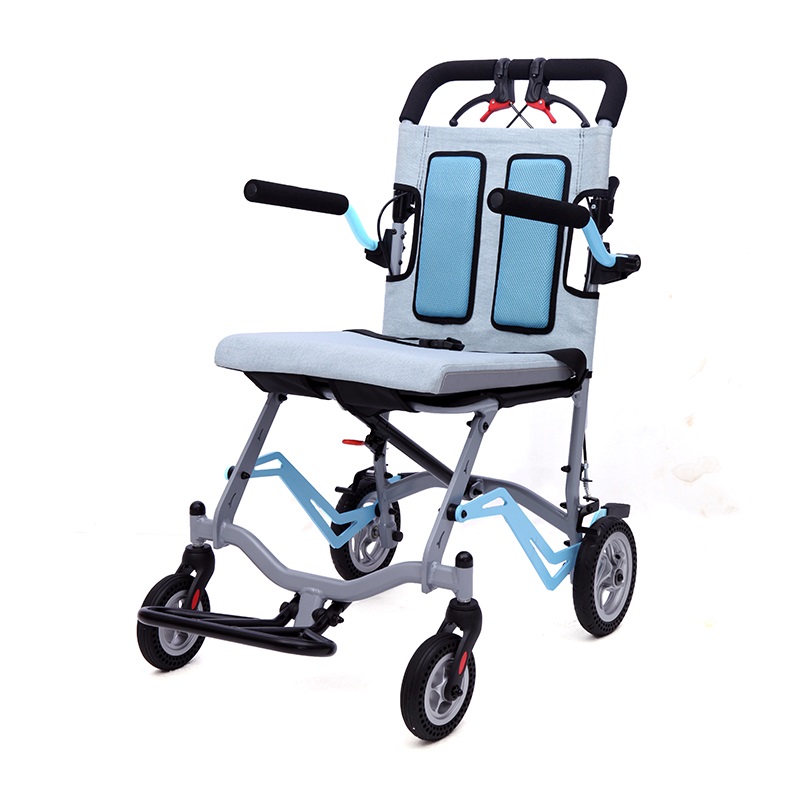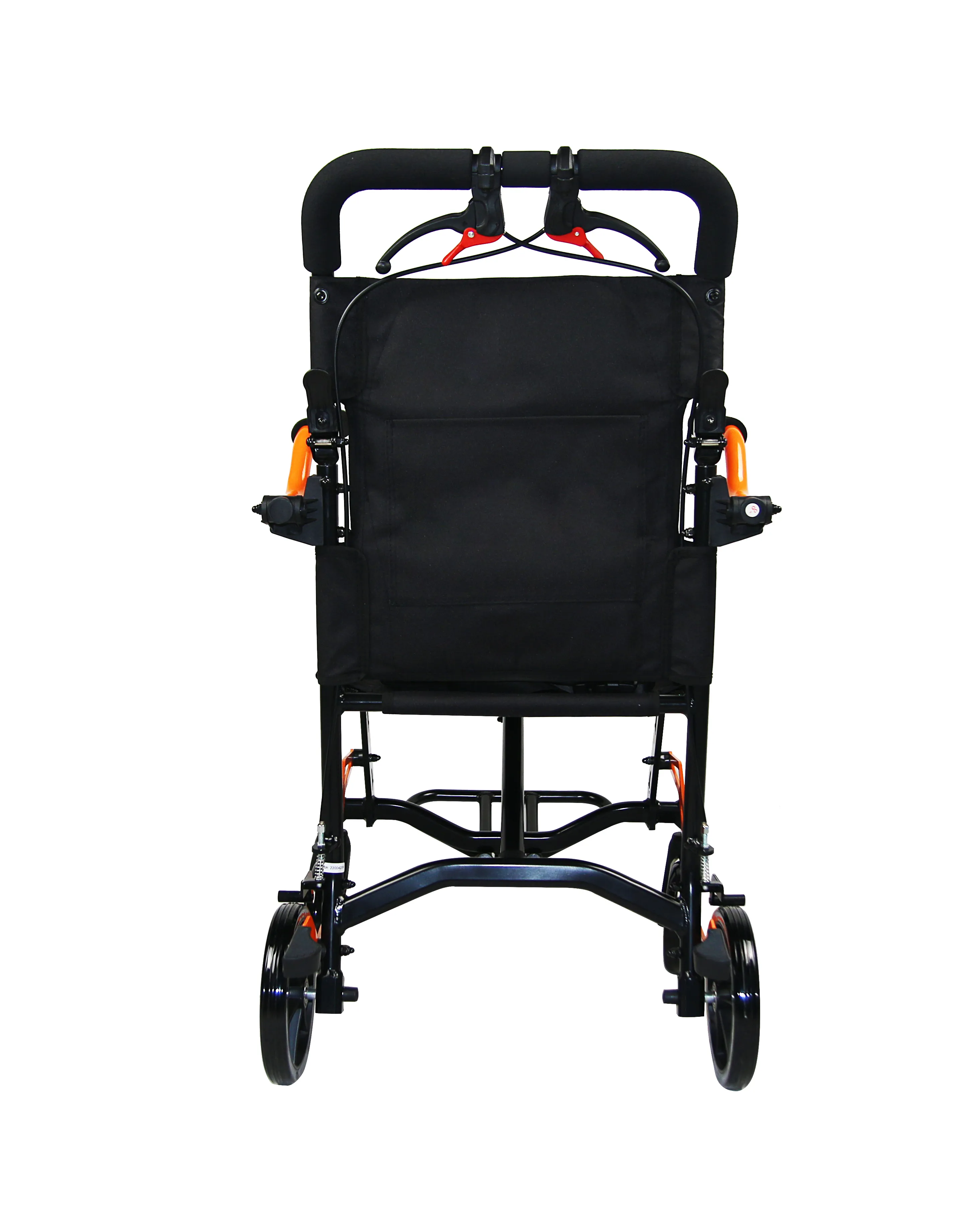Wheelchairs are not only a means of transportation for people with physical disabilities, but also a widely used tool in hospitals, nursing homes, airports, tourist attractions and other places. Especially in scenarios where others are needed to help push the wheelchair, how to choose a wheelchair that is "most suitable for people to push" has become one of the most concerned technical issues for caregivers and purchasers.
There are many types of wheelchairs commonly seen on the market, ranging from structure, materials, functions to sizes. So, from a professional perspective, which wheelchair is most suitable for being pushed by others? The general conclusion in the industry is that lightweight transport wheelchairs are undoubtedly the optimal solution for pushing experience and portability.
This article will focus on the core issue of "which wheelchair is most suitable for people to push", and will deeply explore the design elements, pushing efficiency, structural advantages and scene adaptability of wheelchairs, and comprehensively analyze why lightweight transport wheelchairs have become the first choice.

What is the standard for a wheelchair that is "suitable for people to push"?
In clinical rehabilitation engineering and nursing, wheelchairs suitable for human pushing should meet the following technical and ergonomic standards:
·Light weight of the whole vehicle: easy to carry, lift and push for a long time;
·Low resistance: small friction between the rear and front wheels, smooth bearings, and more labor-saving when pushing;
·Ergonomically designed handle: comfortable grip and stable operation;
·Flexible body and small turning radius: suitable for operation in narrow spaces;
·Complete safety structure: equipped with auxiliary functions such as brakes, anti-roll bars, leg rests, and armrests.
Products that meet the above conditions can significantly reduce physical burden, improve control accuracy, and reduce accident risks during actual pushing. The "lightweight transport wheelchair" is a portable nursing tool built with this as the core of the design.

What is a lightweight transport wheelchair?
A lightweight transport wheelchair is a wheelchair designed for others to push and use. Different from a traditional manual wheelchair, it has a small rear wheel size, a compact body structure, a light weight, and is easy to fold and store. Most lightweight transport wheelchairs do not have self-driving large wheels, which means that users cannot push them by themselves and are completely dependent on caregivers for control.
Core features:
Parameters | Description |
| Weight | Usually between 7 and 12 kg, more than 30% lighter than ordinary manual wheelchairs |
| Rear wheel size | Mostly 8 to 12 inches, easy to turn and control |
| Handle design | The push handle can be folded or height-adjustable to meet the human grip angle |
| Folding mechanism | Quickly folded and stored for easy travel and transportation |
| Material | Lightweight structure such as aluminum alloy/aviation titanium alloy/high-strength composite plastic |
Lightweight transport wheelchairs are not only convenient for caregivers to operate, but are also suitable for daily use such as short-distance transfer of patients, temporary movement, and public transportation.
Why are lightweight transport wheelchairs most suitable for "people pushing"?
1. The weight advantage brings effort-saving pushing
For the pusher, the most obvious feeling is "lightness". Lightweight transport wheelchairs are made of lightweight materials (such as aluminum alloy), which effectively reduces the overall mass:
· Ordinary steel structure wheelchairs weigh about 18~20kg;
· Standard aluminum alloy manual wheelchairs weigh about 14~16kg;
· Lightweight transport wheelchairs weigh only 7~12kg, and the pushing resistance is greatly reduced.
On a flat indoor or outdoor hardened ground, pushing a lightweight transport wheelchair almost does not feel the weight, which is very suitable for women, the elderly, or caregivers to use frequently.
2. Compact structure and flexible control
Lightweight transport wheelchairs adopt short wheelbase, narrow seat width and compact structure:
· Smaller turning radius, can flexibly move through narrow spaces such as corridors, toilets, elevators, etc.;
· Low center of gravity, concentrated force points, easier to control direction;
· Stable frame structure, can maintain straight driving even with one hand.
This allows the pusher to deal with complex paths or crowded areas more calmly and reduce operating pressure.
3. Optimization of handle and brake system to improve operational safety
Lightweight transport wheelchairs are usually equipped with push brake system and ramp control assistance:
· Push brake is convenient for speed control up and downhill;
· Anti-slip texture design of the handle is ergonomic;
· Some models support "one-hand brake lock" to prevent caregivers from letting go and sliding.
In addition, the push handle is designed to be of moderate height, which reduces the burden of bending over for caregivers and improves the comfort of long-term pushing.

Lightweight transport wheelchairs VS other wheelchairs: comparative analysis
In order to further highlight the advantages of lightweight transport wheelchairs, the following is a comparison of common wheelchair categories on the market:
Category | Is it suitable for others to push? | Difficulty of operation | Promote comfort | Weight | Can it be self-propelled? |
| Lightweight transport wheelchair | ✅ Very suitable | ★☆☆☆ | ★★★★★ | 7–12kg | ❌ |
| Standard manual wheelchair | ✅ Moderately suitable | ★★★☆ | ★★☆☆☆ | 14–20kg | ✅ |
| Heavyweight manual wheelchair | ✅ Difficult | ★★★★ | ★☆☆☆☆ | 20–30kg | ✅ |
| Electric wheelchair | ❌ Not recommended | No need to push | No such requirement | ≥25kg | ✅Electric operation |
As can be seen from the table, lightweight transport wheelchairs are almost unmatched in terms of "suitability for people to push", and are particularly suitable for nursing use scenarios.
Advantages of lightweight transport wheelchairs in common use scenarios
Lightweight transport wheelchairs have extremely high push adaptability in the following environments:
1. Hospital care
When pushing patients to check, treat or leave the hospital, caregivers can quickly unfold the wheelchair for pushing, saving time and effort.
2. Nursing homes
Staff members need to push multiple elderly people to eat, bathe, and sunbathe outdoors every day, and lightweight transport wheelchairs reduce their burden.
3. Tourist attractions/airports
Lightweight folding wheelchairs are easy to store at the rear of the car or on the luggage rack, and can be quickly stored after use, which is suitable for short-distance travel needs.
4. Family care
Relatives push wheelchairs up and down stairs, go out to buy groceries, go to the doctor, etc. for elderly people with limited mobility. Lightweight transport wheelchairs provide the greatest convenience.
Lightweight transport wheelchair: Technical parameters to pay attention to when purchasing
When purchasing a wheelchair suitable for pushing, users should pay attention to the following technical indicators:
Technical indicators | Recommended range | Description |
| Vehicle weight | ≤12kg | The lighter the better, easy to carry and transport |
| Rear wheel diameter | 8–12 inches | The small wheels are more flexible and suitable for indoor propulsion |
| Material | Aluminum alloy or titanium alloy | Ensure strength while reducing weight |
| Folding method | One-touch folding or tool-free folding | Improve operating efficiency |
| Handle height | ≥90cm | Reduce bending and improve control comfort |
| Whether it has brakes | Must have | Ensure safety during use |
Is a lightweight transport wheelchair suitable for everyone?
It should be noted that the original intention of the design of lightweight transport wheelchairs is to "be pushed" rather than "self-pushing", and it is suitable for the following groups:
1. Stroke patients who cannot control the wheelchair by themselves;
2. Rehabilitators who need short-distance transfer;
3. Elderly people, postoperative patients;
4. Temporary users in public places.
For long-term daily users and those with strong self-care ability, manual self-propelled wheelchairs or electric wheelchairs are still recommended.

Lightweight transport wheelchairs are the most suitable wheelchair choice for "people pushing"
Under the proposition of "which wheelchair is most suitable for people pushing", combined with multiple dimensions such as ease of operation, weight control, usage scenarios, and design structure, lightweight transport wheelchairs are undoubtedly the best answer at this stage.
While satisfying the experience of the pusher, it also takes into account the comfort, safety and convenience of the pushed, and has become a standard configuration in many fields such as medical care, family care, and public facilities.
Lightweight transport wheelchairs are the most reliable solution for caregivers who want to reduce their burden and improve their work efficiency, as well as temporary patients and elderly people who need to travel.
Why choose a China-based manufacturer like Dayang?
Selecting Dayang Medical means partnering with a vertically integrated factory offering direct production, R&D, and sales of medical equipment in Foshan since 2009. As an ISO 9001/13485, FDA, TUV, and CE-certified supplier.
We provide high-quality, cost-effective products—electric/manual wheelchairs, hospital beds, walkers, commodes, rollators, shower chairs, and walking sticks—all available for bulk purchasing, wholesale, customization, and discounted prices. Get quotes today and discover premium medical device value at factory rates.










